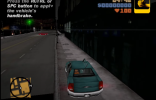I agree with you that at 44s in the first video, it's 20 something fps. At the earlier parts I counted, the driving, it's never getting that high. The off-screen one has some terrible frame pacing/weirdness, resulting in two visible changes per 'frame'. However, these are completely absent from the direct-capture, so I'm guessing it's some display-capture artefacting.
Actually I'm not even sure it's 20 fps where you say. Are we seeing TV motion interpolation in effect? There's very odd movements and smearing. You have a fairly regular 10-12 fps pacing, and then suddenly these moments of multiple small frames between larger changes, in between frames when the scenery moves but the animation doesn't change.
eg. This composite of two frames. Check the ghosting on the notice board.
View attachment 11869
I feel this source is unreliable and we don't need it anyway as we have the direct feed.
Going just off that, counting various points I'd say the game (or most accurately that video of it) is presently averaging around 10-11 fps. Lowest I've counted is 9 fps. At 1:11 frame counting in the video editor, it hits about 20 fps turning right in front of the grass but you can notice that as visibly smoother playing the video, and such smoother moments are very rare placing the average as pretty consistent with little variation.


